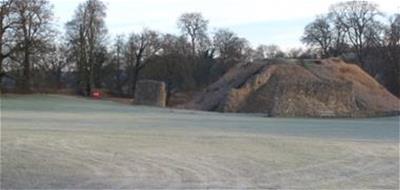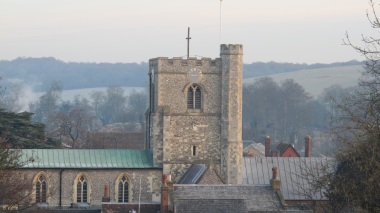History of Berkhamsted
The moat and grounds of Berkhamsted Castle stand close to the town centre, while the Plantagenet Parish Church dominates the High Street next to the 15th century Court House.
Places of historical interest
-
Berkhamsted Castle
 Anybody walking around the castle ramparts, now cared for by English Heritage on behalf of the Duchy of Cornwall, will be aware that this must have been the scene of important events.
Anybody walking around the castle ramparts, now cared for by English Heritage on behalf of the Duchy of Cornwall, will be aware that this must have been the scene of important events.Berkhamsted played a crucial part in England's history late in 1066 when, following the Battle of Hastings, the Norman Duke William sought to complete his conquest. The death of King Harold had not been sufficient for him to claim the throne and he set about a campaign of attrition in the countryside to the south of the river Thames.
The Saxon rulers were unable to stop his advance and finally capitulated, parleying with him at Berkhamsted.
Berkhamsted had been an important place in Saxon times, being an ancient Burgh, although it is not thought that a castle existed until William the Conqueror's reign. Soon after his coronation in Westminster Abbey in December 1066, he gave out lands to his supporters. His half-brother Robert, the Count of Mortaigne, was given Berkhamsted and much of the land for many miles around. It is believed that Robert quickly had the castle built in traditional Norman style. A high conical earth tower topped by a wooden palisade formed the main defence. Surrounded by a deep ditch, this must have been impregnable to the armies of the day.
As military techniques improved more permanent structures became essential. Situated close to water, an elaborate triple moat system formed an outer barrier surrounding the curtain walls. The lack of local stone meant that the materials had to be mainly flint but the plentiful chalk would have provided a useful source for burning lime to cement them. Their strength is shown by the extensive amount of walls still standing despite the attempts of Tudor landowners using the castle remains as a quarry.
 From 1155-65 the castle was held by Thomas Becket who spent a considerable fortune on re-building it. The only record of its use in warfare is in December 1216 when the castle's defenders surrendered after a three-day siege by Prince Louis of France.
From 1155-65 the castle was held by Thomas Becket who spent a considerable fortune on re-building it. The only record of its use in warfare is in December 1216 when the castle's defenders surrendered after a three-day siege by Prince Louis of France.Richard Earl of Cornwall, was one of the prominent owners; as was his son, Edmund, who founded the monastery at Ashridge.
Geoffrey Chaucer is best known as the author of the Canterbury Tales but in his position as Clerk of Works to the Royal Castles, Berkhamsted came under his care. That said, there is no record of his actually having visited. In 1469 Edward IV gave the castle to his mother, Cicely, Duchess of York. She lived there until her death in 1495 after which the castle closed and gradually fell into disrepair.
The walls formed an excellent source of building material. Berkhamsted Place, an impressive Tudor mansion was largely built from the material of the castle by Sir Edward Carey who leased the castle from Elizabeth I. This later became the home of John Sayer, chief cook to James II.
-
St. Peter’s Church
 The second largest church in Hertfordshire
The second largest church in Hertfordshire
- Dates from the 13th century
- The oldest part being the Lady Chapel
- Extended and added to over the centuries, it reached its present size in the fifteenth century
- The tower reached its present height a hundred years later
- Restoration was carried out in Victorian times and again in the 1980s
- Fine memorials and stained glass windows
More information is available on the St Peter's Church website. -
Dean Incent’s House
- Dates from the latter half of the 15th century
- Incorporates part of an even older structure
- It was used as a public meeting place before the Court House was built
- The house was the home of Robert Incent, Secretary to Cicely, Duchess of York at Berkhamsted Castle
- His son John, later Dean of St Paul’s and founder of Berkhamsted School, was probably born here.
-
The Court House
- Dates from the Tudor period and formerly had two storeys
- As a result of the Royal Charter of 1618 (James I) a Court of Records was held here and the Corporation kept standard weights and measures
- In 1838 the building became part of the National School, when the adjoining house was built for the headmaster.
-
Sayer’s Almshouses
- Built in 1684 as the result of a gift of £1,000 left in trust by John Sayer, chief cook to Charles II
- Providing accommodation for six poor widows
- Sayer lived at Berkhamsted Place. His tomb is in St Peter’s Church.
-
The Bourne School
- Thomas Bourne bequeathed £8,000 to build and endow a charity school, opened in 1737 for 20 boys and 10 girls
- In 1853 the school was extended largely through a donation from General John Finch of Berkhamsted Place
- In 1875 the children transferred to the National School in the Court House
- In 1888 the Bourne School became the first home of Berkhamsted School for Girls
- The coats of arms above the door are those of Berkhamsted, Thomas Bourne and John Finch.
-
St John’s, Chesham Road
- On 2 October 1904 the author Graham Greene was born in this Berkhamsted School boarding house, of which his father was housemaster
- Charles Greene later became headmaster
- With the formation of the Berkhamsted Collegiate School the house became a girls’ boarding house.
-
Berkhamsted Collegiate School, Castle Street campus
- Formerly Berkhamsted School
- Founded in 1544 (School House)
- The Chapel is late 19th century and Deans’ Hall early 20th century
- Newcroft was opened by the Queen Mother in 1958.
-
Berkhamsted Collegiate School, Kings Road campus
- Formerly Berkhamsted School for Girls
- Founded in 1887
- Housed originally in the Bourne School
- The school moved to Kings Road in 1902
- Further buildings were opened by the Queen Mother in 1957
- Later a new hall was built to mark the Centenary.
-
The Town Hall
- Built in 1859
- Designed by Edward Buckton Lamb
- Comprised a market hall, large assembly hall, and rooms for the Mechanics’ Institute
- It replaced a mediaeval market hall near present-day Tesco
- Destroyed by fire in 1854
- The clock was erected in 1897 in memory of Thomas Read, who was described in his obituary as the "most remarkable man in Berkhamsted".
-
The King’s Arms
- A large coaching inn
- Dates from the reign of Queen Anne, whose arms, rather than those of a king, are displayed on the sign
- King Louis XVIII of France, exiled to Hartwell House in Aylesbury, carried on a romance here with Polly Page, the innkeeper’s daughter.
-
The Rex Cinema
- Built in 1938
- Fine art-deco interior by David Nye
- It replaced Egerton House, a fine Elizabethan mansion, the home of the Llewellyn- Davies family, on whose children JM Barrie based the story of Peter Pan
- Has now been restored as a fully functioning cinema, visit its website at www.therexberkhamsted.com.
Page Last Updated: Monday, 04 July 2016 at 03:01 PM
We are currently experiencing issues with our online payment system. Our provider is working to fix the problem as soon as possible. If your payment will not go through, please try again later. We apologise for any inconvenience caused
